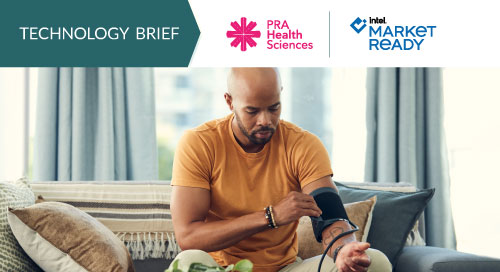Healthcare Tech Boosts Patient Well-Being

Telehealth technology usage has surged, helping reduce the risk of spreading COVID-19. While replicating office visits is an effective use of the tools, they also create opportunities for care and research. Patient-friendly solutions use IoT devices to help change how healthcare is delivered. Healthcare providers can remotely monitor and track patients to reduce rehospitalization and emergency visits. And researchers can automate collecting patient data for clinical trials.
“We’ve seen an evolution in how patients engage with care team providers,” says Enrique Estrada, director of strategic solution sales for PRA Health Sciences, a global healthcare intelligence partner. “This has transitioned from the traditional telephony model 20 years ago to using smart devices and mobile applications today. We are still meeting the patients where they are at, but now looking at what levels of engagements make the most sense for them.”
This is where the company’s remote healthcare solution—Care Innovations Health Harmony—comes in.
When patients are deemed good candidates, the healthcare provider or researcher can have monitoring tools shipped to them. The kit includes Bluetooth-connected devices specific to the patient’s clinical program, such as a pulse oximeter, blood pressure monitor, glucometer, or scale. Also included is a tablet preloaded with the Health Harmony app, as well as the patient’s information (Video 1).
@PRAHSciences was able to quickly triage and coordinate care of COVID patients before they even knew they were at risk. via @insightdottech
Telehealth Serves the Underserved
One of the strengths of remote healthcare is its ability to reach disadvantaged patients. Health Harmony uses the Intel® Trusted Analytics Platform and an Intel® processor-based computing platform to create predictability models identifying high-risk populations.
The State of Mississippi recently used the solution to monitor diabetic patients.
“Thirteen percent of adults in Mississippi had been diagnosed with diabetes and many more were diagnosed as being prediabetic,” says Estrada. “It was the sixth-leading cause of death in the state”. And with 54% of the population living in rural communities, limited access to healthcare professionals and specialists was one of the biggest challenges.
Because of the dynamics of access to care, the governor challenged the technology sector and Medicaid to come up with a creative solution that could engage patients living with diabetes in rural areas. This led to a valued partnership with Intel®, Care Innovations, and the state to drive a new level of care for their population.
A big barrier was the state’s limited broadband service. Care Innovations worked with the local telecommunications provider to set up cellular connectivity in rural communities, where some of the patients who needed the most care lived. Physicians helped screen candidates, and 100 were enrolled.
Patients are shipped a kit containing a tablet with the Health Harmony application, weight scale, and a glucometer with test strips.
“Once the program was up and running, we saw a dramatic shift in costs,” says Estrada. “Not one patient actively enrolled into the Health Harmony program was readmitted for their underlying conditions. This was amazing on various fronts, from better outcomes to reduced costs to manage chronic conditions across the state.”
“Health costs for diabetic patients are 2.3 times higher than people without diabetes, and 43% of the costs are from hospitalization,” says Estrada. “Mississippi saved more than $339,000 with patients enrolled in the program, and that number could grow to $189 million once 20% of the state’s diabetic population participated.”
Data Analytics Help Diagnose COVID-19
The platform is extensible to meet various changes in workflow and new additions to clinical programs. For example, with the COVID outbreak, Care Innovations was able to quickly extend the platform to new patient services focused on symptoms, CDC guidelines, at-home testing, and clinical surveillance.
“During the peak of the pandemic, some of our customers modified their clinical view to look at key conditions that were symptomatic with COVID,” says Estrada. “They were able to quickly triage and coordinate care of these patients before they even knew they were at risk. This allowed the healthcare provider to manage care, reduce the impact on the healthcare delivery system, and avoid critical situations.”
The Health Harmony tablet dashboard connects to the IoT devices and records daily vital signs. It can be filtered by alerts, conditions, vitals, and highest-risk patients based on a risk algorithm. Clinicians monitor patients and create alerts based on the goal and outcomes of the program.
A Managed Solution
Finding a managed end-to-end telehealth solution allows busy clinicians to focus on patient care. Care Innovations works with clients to identify desired outcomes, assess the population, and help recruit patients. The company also identifies drivers of the program and barriers that need to be addressed.
“Once we understand the goals and outcomes of the program, we create a line of services and technology to support the program,” says Estrada. “This involves our clinical managers actively getting involved in the design of the workflows, associated devices, and care pathways target for remote patient care.”
The company continues to innovate its product and services based on client feedback to deliver the best outcomes, and costs. The future of healthcare technology is all about improving the human experience.